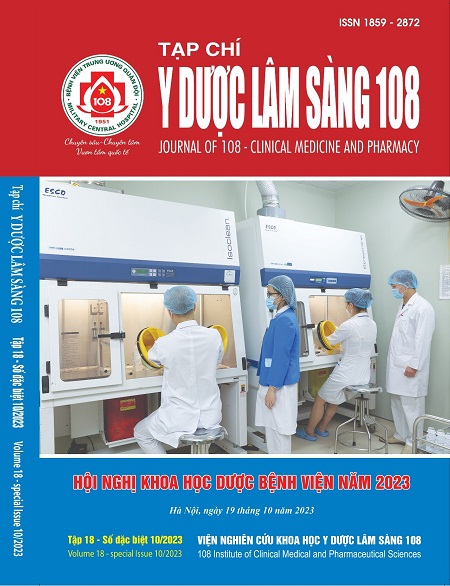Analysis of the results of implementing the monitoring of vancomycin concentration in pediatric patients using a Bayesian approach at Saint Paul General Hospital
Main Article Content
Keywords
Abstract
Objective: To analyze the results of implementing the monitoring of drug concentration and adjusting vancomycin dosage in pediatric patients based on a Bayesian approach. Subject and method: This is a prospective observational study conducted on pediatric patients under 16 years old who meet the criteria of the vancomycin concentration monitoring procedure. The proposed vancomycin dosage regimen is estimated to achieve a target AUC24/MIC within the optimal range of 400-600 mg.hours/L, using a Bayesian approach on Precise PK program. The level of AKI is measured according to KDIGO 2012. The study is conducted at Saint Paul General Hospital from June 1, 2022, to June 1, 2023. Result: The study involved a total of 98 pediatric patients with a median age of 1.5 (0.57-3.35) years old having TDM vancomycin in the study period. The median initial dose was 58.8 (56.0-61.6) mg/kg/day and 23 (23.5%) patients attained the target AUC24/MIC at the first time, with a median of 355.81 (289.05-492.12) mg.h/L. After dose adjustment, the percentage of patients achieving the target AUC24/MIC of 400-600 mg.hour/L increased significantly, to 41.2% (14/34), 70% (7/10), and 100% (1/1) respectively after the second, third and fourth TDM. There was no AKI case recorded after treating with vancomycin. Conclusion: TDM vancomycin with AUC24/MIC target of 400-600 using Bayesian approach in pediatric patients plays an essential role in ensuring treatment effectiveness and minimizing toxicity when using vancomycin in this patient population.
Article Details
References
2. Bruniera FR, Ferreira FM, Saviolli LR, Bacci MR, Feder D, da Luz Gonçalves Pedreira M, Sorgini Peterlini MA, Azzalis LA, Campos Junqueira VB, Fonseca FL (2015) The use of vancomycin with its therapeutic and adverse effects: A review. Eur Rev Med Pharmacol Sci 19(4): 694-700.
3. Frymoyer A, Hersh AL, El-Komy MH, Gaskari S, Su F, Drover DR, Van Meurs K (2014) Association between vancomycin trough concentration and area under the concentration-time curve in neonates. Antimicrob Agents Chemother 58(11): 6454-6461.
4. Kidney Disease: Improving Global Outcomes (KDIGO) Acute Kidney Work Group. (n.d.) (2012) KDIGO Clinical Practice Guideline for Acute Kidney Injury: 1-138.
5. Le J, Bradley JS, Murray W, Romanowski GL, Tran TT, Nguyen N, Cho S, Natale S, Bui I, Tran TM, Capparelli EV (2013) Improved vancomycin dosing in children using area under the curve exposure. Pediatr Infect Dis J 32(4):e155-163. doi: 10.1097/INF.0b013e318286378e.
6. Le J, Capparelli EV, Wahid U, Wu YS, Romanowski GL, Tran TM, Nguyen A, Bradley JS (2015) Bayesian estimation of vancomycin pharmacokinetics in obese children: Matched case-control study. Clinical Theraprutics 37(6): 1340-1351.
7. Rybak MJ, Le J, Lodise TP, Levine DP, Bradley JS, Liu C, Mueller BA, Pai MP, Wong-Beringer A, Rotschafer JC, Rodvold KA, Maples HD, Lomaestro BM (2020) Therapeutic monitoring of vancomycin for serious methicillin-resistant Staphylococcus aureus infections: A revised consensus guideline and review by the American Society of Health-System Pharmacists, the Infectious Diseases Society of America, the Pediatric Infectious Diseases Society, and the Society of Infectious Diseases Pharmacists. American Journal of Health- System Pharmacy 77: 835-864.
 ISSN: 1859 - 2872
ISSN: 1859 - 2872
